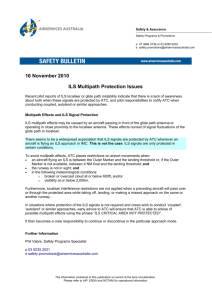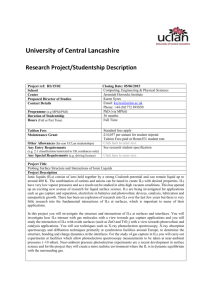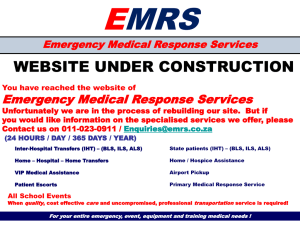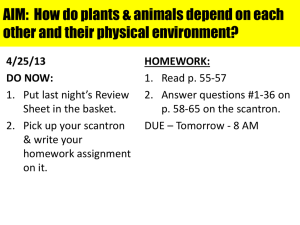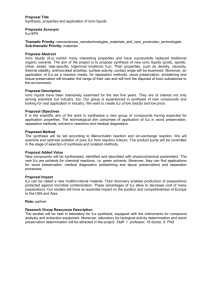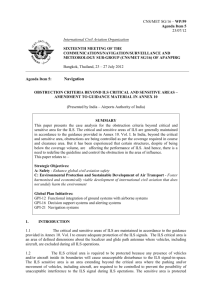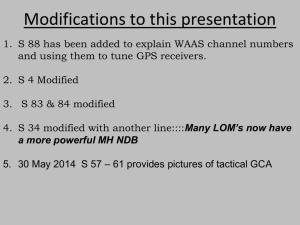ILS Approach with B737: Training Guide
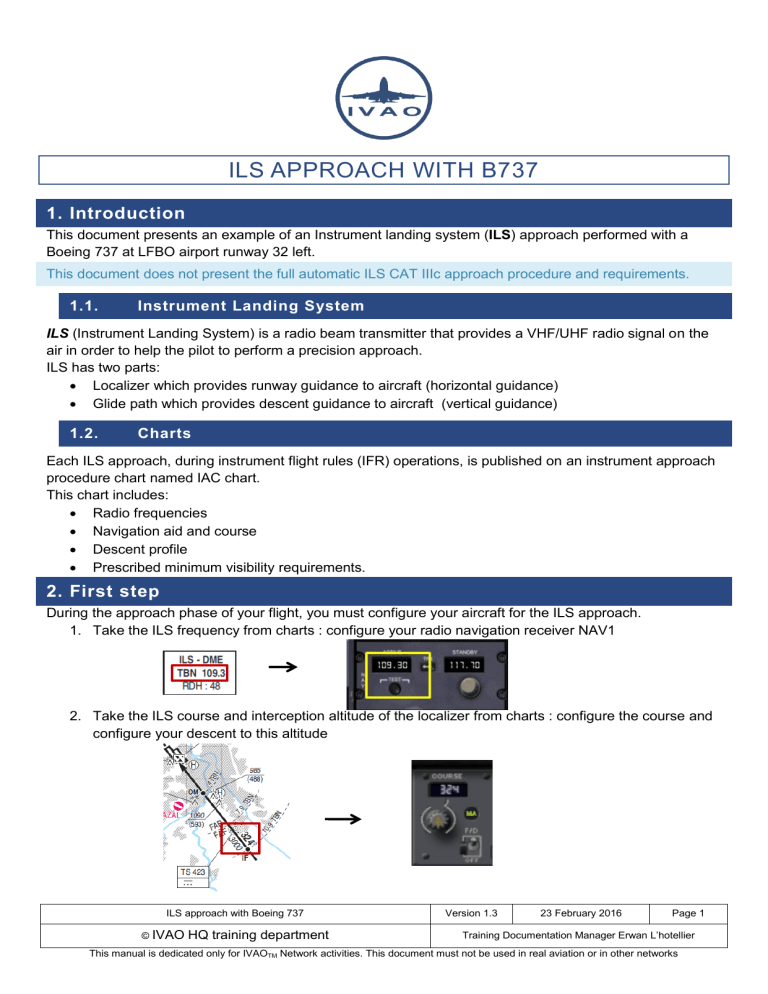
ILS APPROACH WITH B737
1. Introduction
This document presents an example of an Instrument landing system ( ILS ) approach performed with a
Boeing 737 at LFBO airport runway 32 left.
This document does not present the full automatic ILS CAT IIIc approach procedure and requirements.
1.1. Instrument Landing System
ILS (Instrument Landing System) is a radio beam transmitter that provides a VHF/UHF radio signal on the air in order to help the pilot to perform a precision approach.
ILS has two parts:
Localizer which provides runway guidance to aircraft (horizontal guidance)
Glide path which provides descent guidance to aircraft (vertical guidance)
1.2. Charts
Each ILS approach, during instrument flight rules (IFR) operations, is published on an instrument approach procedure chart named IAC chart.
This chart includes:
Radio frequencies
Navigation aid and course
Descent profile
Prescribed minimum visibility requirements.
2. First step
During the approach phase of your flight, you must configure your aircraft for the ILS approach.
1. Take the ILS frequency from charts : configure your radio navigation receiver NAV1
2. Take the ILS course and interception altitude of the localizer from charts : configure the course and configure your descent to this altitude
ILS approach with Boeing 737 Version 1.3 23 February 2016 Page 1
©
IVAO HQ training department Training Documentation Manager Erwan L’hotellier
This manual is dedicated only for IVAO
TM
Network activities. This document must not be used in real aviation or in other networks
3. Before joining the localizer
Before joining the localizer, you must check the following points:
1. Aircraft speed shall be reduced to between 180KT and 220KT .
2. Aircraft descent altitude shall be set to the interception altitude of the localizer published on charts.
3. Aircraft flaps are set to 5° position .
4. If you want to perform an automatic ILS approach, the APP button shall be activated
5. Set auto brake to adequate value
When performing an ILS approach, you must establish the localizer before the glide path.
You can consider being established when the indicator is staying at the central position ± 1 bullet.
If you are far from the localizer path and glide path, all ILS indicators are set to maximum deviation and remain at this position (like the image hereunder). If you are close to the path, the indicator shall move to the central position.
When the localizer indicator is on the left it means that the localizer path is on the aircraft’s left, or the aircraft is on the right of the localizer path.
An ILS approach can be performed manually by the pilot. The use of autopilot is not mandatory
ILS approach with Boeing 737 Version 1.3 23 February 2016 Page 2
©
IVAO HQ training department Training Documentation Manager Erwan L’hotellier
This manual is dedicated only for IVAO
TM
Network activities. This document must not be used in real aviation or in other networks
4. Establishing on the localizer
When the localizer indicator is moving to the central position, you must turn toward the runway.
You must adjust your heading in order to keep the localizer indicator near the centre position.
By doing so, you will keep the runway alignment until touchdown.
In the picture hereunder, you can notice:
1. The localizer indicator is near the centre bar (red). You are established on the localizer.
2. The glide indicator is still at the maximum deviation (green). You are still below the glide path.
When the glide indicator is on the top it means that the glide path is above the aircraft or the aircraft is below the glide path.
During normal ILS approach, you must always intercept and establish on the localizer when the glide path indicator is on top or above the middle (like the image above n°2).
The spoilers can be armed at this stage.
The runway can be seen now (depends on the weather, distance)
ILS approach with Boeing 737 Version 1.3 23 February 2016 Page 3
©
IVAO HQ training department Training Documentation Manager Erwan L’hotellier
This manual is dedicated only for IVAO
TM
Network activities. This document must not be used in real aviation or in other networks
5. Establishing on the glide path
When the glide path indicator is moving to the central position, you must initiate your descent:
1. Reduce the power and speed down to 160kt
2. Set the flaps to 15° position
3. Set gear leveller to down position. And check that the gear feedback indicators are green
4. Maintain localizer and glide path indicator near the centre position.
5. Check you vertical speed indicator. The approximate value shall be calculated: ground speed x descent path in degrees (example: 160kt x 5° = 800ft/min).
You must adjust your pitch and power in order to keep the glide path indicator near the centre position.
By doing so, you will maintain a constant descent until the short final.
When localizer and glide path indicator are located near the middle of the indicator, you can consider the
ILS being established.
ILS approach with Boeing 737 Version 1.3 23 February 2016 Page 4
©
IVAO HQ training department Training Documentation Manager Erwan L’hotellier
This manual is dedicated only for IVAO
TM
Network activities. This document must not be used in real aviation or in other networks
6. Check point at the outer marker
When stabilized on the ILS, it is time to check your approach progress:
1. Locate on your charts the intermediate altitude check mainly located at the outer marker (OM on chart).
2. Check the altitude when reaching this point (it can be a DME distance or navigation aid reference)
3. Set final approach speed and flaps. Here set 140kt and select flaps 30° to 40°.
In the example, the altitude to check is 1760ft at 4NM DME of TBN radio navigation aid.
When the descent rate is stabilized, the approach speed should be reduced to the final approach speed.
ILS approach with Boeing 737 Version 1.3 23 February 2016 Page 5
©
IVAO HQ training department Training Documentation Manager Erwan L’hotellier
This manual is dedicated only for IVAO
TM
Network activities. This document must not be used in real aviation or in other networks
7. Approaching decision altitude
When you will be on short final, it is time to decide to land or go around, after the Outer Marker:
1. Check on your charts the decision altitude (on chart you will find mainly ILS CAT I decision altitude)
2. Program your go around altitude on the autopilot panel.
3. Check that the aircraft speed is stabilized at the target speed and disable auto throttle for final landing
4. When reaching decision altitude, you need to decide to land or go around. At this time, you must disconnect the autopilot if it is still engaged
At decision altitude, if you see the runway or 3 consecutive approach lights on the ground, you can continue the ILS approach, if you don’t have this visual reference, you must go around.
The aircraft must be stabilized on final in landing configuration at least 1000 ft above the ground. The pilot in command shall not hesitate to go around if his aircraft is not stabilized on final, or the approach speed is excessive.
ILS approach with Boeing 737 Version 1.3 23 February 2016 Page 6
©
IVAO HQ training department Training Documentation Manager Erwan L’hotellier
This manual is dedicated only for IVAO
TM
Network activities. This document must not be used in real aviation or in other networks
8. Recommended elements of a stabilized approach
We just give you the following recommendation consistent with criteria developed by the Flight Safety
Foundation.
Note that the recommended elements of a stabilized approach can differ slightly in function of the aircraft operation manual or company recommendations.
All approaches should be stabilized by 1000 feet in IMC and 500 feet in VMC.
An approach is considered stabilized when all of the following criteria are met:
The aircraft is on the correct flight path.
Only small changes in heading and pitch are required to maintain the correct flight path
The airplane speed is not more than V
REF
+ 20 Knots indicated airspeed and not less than V
REF
The airplane is in the correct landing configuration.
Sink rate is not greater than -1000 feet/minute except if the approach procedure requires a sink rate greater than -1000 feet/minute.
Thrust settings appropriate for the airplane configuration.
All briefing and checklist have been conducted.
ILS approach should be flown within one dot of the glide slope and localizer, or within the expanded localizer scale.
During circling approach, wings should be level on final when the airplane reaches 300 feet
Pitch attitude is between +10° and -2.5°
Bank angle is maximum 7°
An approach becoming unstabilized below 1000 feet IMC or below 500 feet VMC requires an immediate go-around.
As the airplane crosses the runway threshold it should be:
Stabilized on target airspeed to within + 10 Knots until arresting descent rate at flare
On a stabilized flight path using normal manoeuvring
Positioned to make a normal landing in the touchdown zone (the first third of the runway)
Initiate a go-around if the above criteria cannot be maintained.
ILS approach with Boeing 737 Version 1.3 23 February 2016 Page 7
©
IVAO HQ training department Training Documentation Manager Erwan L’hotellier
This manual is dedicated only for IVAO
TM
Network activities. This document must not be used in real aviation or in other networks

